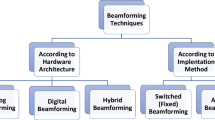Abstract
Ultra wideband (UWB) is a promising technology in delivering high data rate for short range wireless communication systems. Because of their large bandwidth, UWB signals may encounter some problems especially with high sampling rate requirements. Moreover, coherence existence with other narrowband systems is a major concern which needs to be addressed through proper mechanisms. The problem becomes so complex if multiple users exist. Since narrowband interference (NBI) signals have sparse representation in the discrete cosine transform (DCT) domain, they can be estimated and suppressed using Compressive Sensing (CS). CS also has the ability to reduce the high sampling rate requirements. For training based NBI mitigation with CS, three groups of pilot symbols are used to estimate the NBI signal subspace, the UWB signal subspace, and to provide information about the channel. In this paper, the distribution of pilot symbols among the three groups is investigated in the presence of strong NBI. The investigation is based on the bit error rate performance and throughput. The influence of each pilot symbols group is studied. The performance is also evaluated in the presence of multiuser interference in addition to the NBI. Simulation results show that the size of the third group of pilot symbols which is used to estimate the channel is the most dominant one.










Similar content being viewed by others
References
Stitz, T., Ihalainen, T., & Renfors, M. (2006). Mitigation of narrowband interference in filter bank based multicarrier systems. IEEE International Conference Communications, 07, 3241–3246.
Dowla, F., Nekoogar, F., & Spiridon, A. (2004). Interference Mitigation in Transmitted-Reference Ultra-Wideband (UWB). In IEEE International Symposium on Antennas and Propagation Society (pp. 1307–1310)
Nikookar, H., & Prasad, R. (2009). Introduction to ultra wideband for wireless communications. Berlin: Springer.
Jin, B. Z., Zhang, S., Pan, J., & Lin, X. K. (2012). Sub-Nyquist sampling based narrowband interference mitigation in UWB impulse radio. Electronics Letters, 48(15), 963n.
Wang, Z., Arce, G. R., Sadler, B. M., Paredes, J. L., Hoyos, S., & Yu, Z. (Sep. 2008). Compressed UWB signal detection with narrowband interference mitigation. IEEE International Conference on Ultra-Wideband, 2, 157–160.
Shaheen, E. M. (August 2012). Narrowband interference suppression in DS-UWB communication systems using Digital Delay Filter. In 2012 8th International Wireless Communications and Mobile Computing Conference (IWCMC) (pp. 585–590).
Mohammed, A. R., Al-khateeb, K. A. S., Islam, R. (2012). 5. 5–10. 5 GHz IR-UWB pulse generator for narrowband interference mitigation. In International Conference on Computer and Communication Engineering (ICCCE) (pp. 3–5).
Rout, D. K., & Das Member, S. (2013). MHP for narrowband interference mitigation in high data rate UWB body area networks. In IEEE Conference on Information & Communication Technologies (ICT), Ict, (pp. 557–562).
Xu, Z., Nie, H., Chen, Z., Khani, H., & Yu, L. (2012). Nonlinear blind narrowband interference mitigation for energy detection based UWB receivers. IEEE Communications Letters, 16(10), 1596–1599.
Xu, Z., Nie, H., (David) Chen, Z., Khani, H., & Yang, A. (Jan. 2013). Blind narrowband interference mitigation using filter bank for energy detection based UWB receivers. IEEE Radio and Wireless Symposium, 1, 139–141.
Zhang, P., Hu, Z., Qiu, R. C., & Sadler, B. M. (2009). A compressed sensing based ultra-wideband communication system. IEEE International Conference on Communications (pp. 1–5).
Zhang, P. & Qiu, R. C. (2010) Wireless tomography, Part III: Compressed sensing for ultra-wideband signals. Waveform Diversity and Design Conference (WDD), 2010 International (pp. 35–39)
Oka, A., & Lampe, L. (2009). Compressed sensing reception of bursty UWB impulse radio is robust to narrow-band interference. IEEE Global Telecommunications Conference, GLOBECOM 2009 (pp. 1–7).
Zhang, J., Li, Y., & Deng, B. (Jul. 2012). Parameter estimation with narrowband interference suppression based on compressed sensing. IEEE International Geoscience and Remote Sensing Symposium (IGARSS), 2, 3975–3978.
Gomaa, A., & Al-Dhahir, N. (2010). A compressive sensing approach to NBI cancellation in mobile OFDM systems. In IEEE Global Telecommunications Conference (GLOBECOM 2010) (pp. 1–5).
Gomaa, A., & Al-dhahir, N. (2011). A sparsity-aware approach for NBI estimation in MIMO-OFDM. IEEE Transactions on Wireless Communications, 10(6), 1854–1862.
Devi, R. M., & Prema, G. (2012). Compressive sensing algorithm for narrowband interference mitigation in MIMO-OFDM. In International Conference on IEEE Advanced Communication Control and Computing Technologies (ICACCCT), No. 978 (pp. 22–27).
Oka, A., & Lampe, L. (2009). A compressed sensing receiver for bursty communication with UWB impulse radio. IEEE International Conference on Ultra-Wideband (ICUWB), 2009, 279–284.
Wang, Z., Arce, G. R., Paredes, J. L., & Sadler, B. M. (2007). Compressed detection for ultra-wideband impulse radio. In IEEE 8th Workshop on Signal Processing Advances in, Wireless Communications (pp. 1–5).
Wang, Z., Arce, G. R., Sadler, B. M., Paredes, J. L., & Ma, X. (2007). Compressed detection for pilot assisted ultra-wideband impulse radio. In IEEE International Conference on Ultra-Wideband (ICUWB) (pp. 393–398).
Chen, N., Wu, S., Li, Y., & Cao, B. (2013). Compressed sensing enabled narrowband interference mitigation for IR-UWB systems. In International Conference on Wireless Communications & Signal Processing (WCSP), No. 61001092 (pp. 1–5).
Molisch, A. F., Balakrishnan, K., Cassioli, D., Chong, C., Emami, S., Fort, A., Karedal, J., Kunisch, J., Schantz, H., Schuster, U., & Siwiak, K. (2005). IEEE 802. 15. 4a Channel Model—Final Report.
Acknowledgments
This work is supported and funded by the Deanship of Scientific Research (DSR) at King Fahd University of Petroleum & Minerals (KFUPM) through Project No. SB121014. The authors would like to thank Mr. Mohammad T. Alkhodary for his valuable help.
Author information
Authors and Affiliations
Corresponding author
Rights and permissions
About this article
Cite this article
Muqaibel, A.H., Alawsh, S.A. Training Sequence Design for NBI Mitigation in Compressive Sensing UWB Systems. Wireless Pers Commun 78, 1539–1554 (2014). https://doi.org/10.1007/s11277-014-1833-9
Published:
Issue Date:
DOI: https://doi.org/10.1007/s11277-014-1833-9




